The Labyrinth of Litchfield
Orange Is the New Black’s set designer on how the show subtly evokes the claustrophobia of prison.
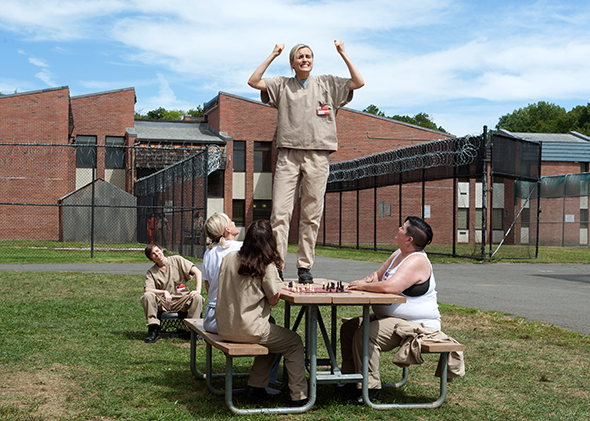
Photo by JoJo Whilden/Netflix
In the third season of Orange Is the New Black, which premiered on Friday, Piper Chapman is no longer be the central focus of the story. Over the course of the season, characters we haven’t heard much from before, including the soft-spoken Chang, get their backstories revealed, and new characters arrive to offer Litchfield Penitentiary more intrigue. This has long been one of the best things about OITNB: the way it pivots from prison scenes to places on the outside—the homes, apartments, playgrounds, and schools where characters had lives before jail—then back again to the beige halls of Litchfield.
The set of OITNB is so convincing that it might not occur to you that it’s a set at all. The design of the fictional Litchfield Penitentiary looks a bit like a building from the 1930s was repurposed in the 1970s, then partially renovated before budget cuts halted construction, then continually jury-rigged into the present day. This layered effect—which captures the feeling we’ve all had of navigating an officious bureaucracy that’s clearly making things up as it goes along—turns out to be a deliberate design choice, intended to mirror the experience of incarceration. It’s not just about being locked up; it’s about the arbitrariness and sense of “making do” that characterize life in prison.
“A great comment I get all the time,” the show’s set designer, Michael Shaw, told me, “is ‘It’s an actual prison, right? Where do you shoot it?’ ”
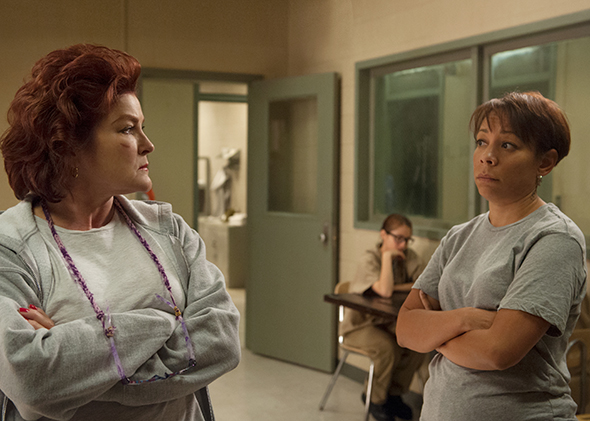
Photo by JoJo Whilden/Netflix
Shaw, who designed Seasons 1 through 3 of OITNB, knew immediately upon reading the series pilot that he didn’t want the set to be an austere, harshly lit dystopia like the set of Oz. Rather than seeming militaristic and efficient, it had to seem patched together. Shaw toured a number of minimum- and maximum-security prisons to get a sense of how they looked, functioned, and differed from one another. Eschewing the traditional three-sided design of TV sets, Shaw felt that the only way to make Piper’s confinement feel palpable was to make the set all-encompassing, 360 degrees.
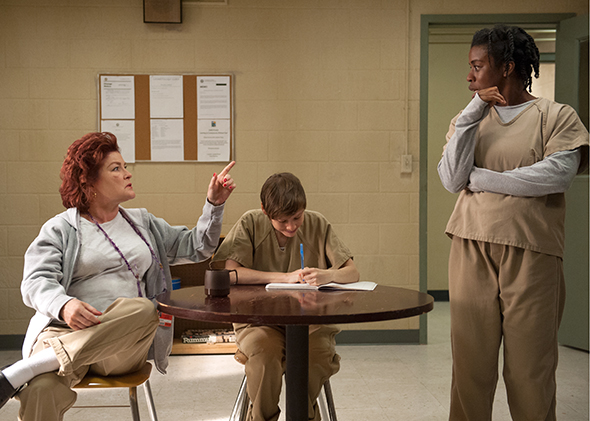
Photo by JoJo Whilden/Netflix
Apart from scenes shot outdoors, most of the action on OITNB takes place on a soundstage in Queens. The set is packed with rich details that make it seem like a real old building found by seasoned location scouts, conjuring what Shaw describes as “the perfect ironic blend of high security and haphazard inefficiency that I was looking for.” Security doors have an original (non-functional) lock on them next to a new lock that may or may not work, next to a padlock on a hasp. Cinderblock walls have visible patches of similar colors of paint layered one on top of the other, and wiring is clearly a work in progress. Shaw wanted the two main areas of activity, the common area and the cafeteria, to feel as though they were adapted from orphaned industrial buildings from the 1930s—a space that clearly had another life, with very high ceilings and enormous factory windows. The open sightlines that prison staff use to surveil inmates also happens to be an important feature of set design, allowing the crew to shoot actors with enough space and light—an odd, but happy accident, Shaw says.
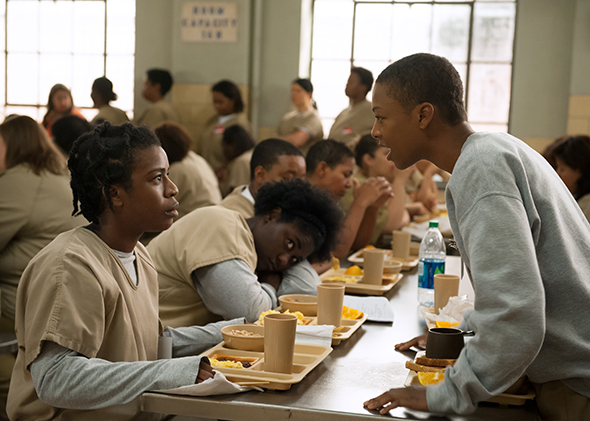
Photo by JoJo Whilden/Netflix
The relationship between inside and outside is crucial, too: Shaw and his team spent weeks sourcing a full set of industrial windows that would let a lot of light in and make it clear that the world outside is rarely accessed, only with permission. The set itself has a backstory within OITNB: as the prison population at Litchfield grew, new sections were added in different eras, so the cafeteria looks like a pre–World War II factory space, while the hair salon, and what Shaw refers to as the “sex and death” utility closet in the hallway, look like elements from a public high school in the 1970s.
The building that poses as Litchfield Penitentiary for outdoor scenes is an abandoned psychiatric facility in Rockland County that was built in the 1970s. For effect, Shaw’s team added razor wire fencing, gates, garden booths, the garden, the track, and the exercise yard. Crucially, the color palette is as limited here as it is inside: While the interior of the prison is a sea of beige and orange uniforms and the bathrooms are coated in a shade of pink Shaw’s team named “sad Band-aid,” the exterior is composed of wood and metal structures, and green grass, making the setting look like a monochromatic Lego set. This is because Shaw wanted to ensure that the distinction between life inside and outside Litchfield was striking, no matter whose backstory was being explored. Even in situations where inmates’ former lives were very poor, scary, or desperate, they are full of color and texture. The outside world has contrast, a multitude of pattern and hue, interesting things to look at, text, signage, decoration, personal effects, and clothing. Inside Litchfield, the color palette becomes myopic, as though half the colors of the spectrum have been eliminated. Solid color walls and clothes dominate, and steel, concrete, hard angles and harsh edges surround the inmates and guards.
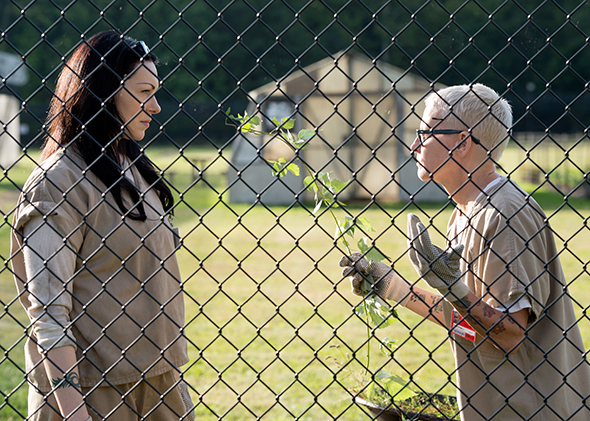
Photo by JoJo Whilden/Netflix
Above all, the world of Litchfield is suffused with bitter irony. “We really took advantage the ironic humor in signs like ‘keep feet off the walls’ and a sign on the fence ‘please keep signs off the fence,’ ” Shaw says, noting the presence of inspirational posters in the common areas that look as though they were mounted 20 years ago and never moved.
Piper Kerman, upon whose memoir the series is loosely based, has described the system of rules that governed the minimum security prison in Danbury, Connecticut, where she served 13 months as “both reasonable and unreasonable,” emphasizing that these rules are “selectively enforced and frequently broken by the prison staff themselves.” Add to this the sometimes arbitrary mandatory sentencing laws that land Americans in jail at a staggering rate (as of 2014, 2.4 million Americans are currently incarcerated, representing a 500 percent increase since 1985). Shaw’s design makes the fictional Litchfield all too real—evoking its claustrophobic interiors so skillfully that, according to Shaw, the first time Kerman visited the set, she couldn’t wait to leave.